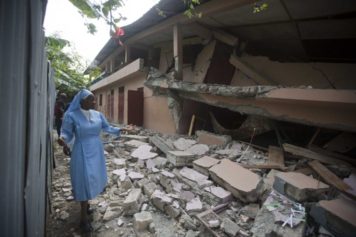Former U.S. President Jimmy Carter was back in Haiti on Monday, doing his part while urging donors from around the world to honor the billion-dollar pledges they made to help the impoverished Caribbean nation rebuild after its devastating 2010 earthquake.
Carter’s call for greater humanitarian aid to Haiti came on the first day of a week-long effort to build 100 homes with about 600 volunteers from Habitat for Humanity.
It was the second time in the past year that Carter, 88, and his wife Rosalynn have come to help house people displaced at the epicenter of the disaster.
“We’ve seen numerous governments in Haiti; they have a very difficult time,” Carter told reporters, noting this was his 11th trip to Haiti. “I think we should give the government of Haiti some breathing room and give them all the support we can, even if there’s some waste of money.”
The country is still feeling the effects of the monstrous January 12, 2010 quake that measured 7.0 on the Richter scale, killing more than 300,000 people while leaving an estimated one million others homeless.
Donor nations and institutions promised $4.46 billion to help Haiti after the quake, but only a little more than half of that money has been released, according to the U.N. Office of the Special Envoy for Haiti.
The reasons for the delays vary, ranging from economic problems back home to a wait-and-see approach until the Haiti’s government gets settled. President Michel Martelly took office in May 2011, but much of his first year was spent without a Cabinet because of political paralysis and infighting.
Carter and the former first lady joined in the construction of the 100 houses on about 14 acres, hammering away and measuring facades. The Carters and fellow volunteers also built 100 homes during a visit a year ago. The effort will result in about 250 homes in total for what organizers say will be a new community, complete with agriculture production.
Still vast numbers of Haitians remain without permanent housing. About 369,000 people live in the tent and tarp settlements that sprung up after the quake, down from a peak of 1.3 million, according to the International Organization for Migration.
“There are still too many tents,” Rosalynn Carter said at a news conference.
Families help build the Habitat homes and then live in them rent-free for five years. After that, they will then pay the government about $70 a year. The homes have a small separate space that can be used as a room or closet, and each tenant receives an outdoor latrine and shower. A well is shared.


